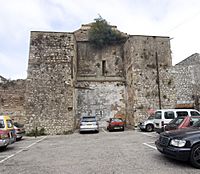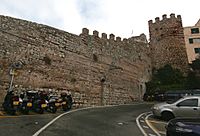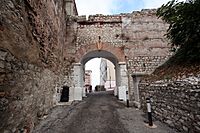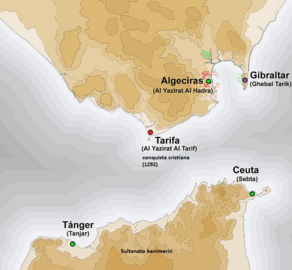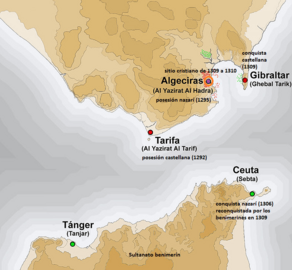Battle of the Strait facts for kids
The Battle of the Strait (called Batalla del Estrecho in Spanish) was a series of fights over important ports in the Strait of Gibraltar. These battles happened in the late 1200s and early 1300s. The main groups fighting were the Muslim Emirate of Granada from Spain, the Christian Crown of Castile (also from Spain), and the Muslim Marinid state from North Africa.
These ports were super important because they connected Spain and North Africa. This link was vital for Muslims in Spain to stay connected with the rest of the Islamic world. The battles had mixed results. Castile managed to keep the port of Tarifa for good. They also captured Gibraltar and Algeciras for a while, but these places later went back to Muslim control. Castile never managed to take any ports on the African side of the strait.
Contents
Why They Fought for the Strait
From the late 1200s to the early 1300s, three powerful groups fought for control of the Strait of Gibraltar. These groups were the Christian kingdom of Castile, the Marinids from Morocco, and the Nasrids from Granada. This long fight, known as "the Question of the Strait," was a big part of the Christian reconquest of Spain. It was during these important clashes that Gibraltar became a key location.
How Gibraltar Became Important
After the Almohad Caliphate (a large Muslim empire) broke apart, and Christian kingdoms started taking back land in Spain, the northern side of the Strait of Gibraltar came under the control of the Nasrid Emirate of Granada. This was a smaller Muslim state that followed the larger al-Andalus.
Gibraltar was likely given to the Marinid sultan Abu Yusuf Yaqub ibn Abd Al-Haqq of Morocco in 1274. The Nasrid sultan Muhammad II gave it to him, along with Algeciras, as payment. This was to thank the Marinids for helping Granada fight against Castile. Some records say this happened in 1275, and that Tarifa, Algeciras, and Gibraltar were given to the Marinids to use as naval bases.
In 1292, Sancho IV of Castile wanted to control the Strait. His troops attacked Tarifa and easily captured it. Two years later, the Marinids tried to take Tarifa back, but they failed. The city was defended by Guzmán el Bueno, known as "the Good." After this loss, the Marinid rulers decided to go back to North Africa. They sold their remaining ports in Spain to the sultans of Granada.
Gibraltar's Role in Defense
Even though there aren't many old documents about Gibraltar after a project called Madinat al-Fath, people believe a small fortified town existed there. This town likely appeared because Tarifa fell in 1292.
After Tarifa was captured, people expected Sancho to attack Algeciras next. This would have cut off the Marinids' easiest way to reach Spain. The threat of a Christian stronghold to the west probably led to a military base being set up east of Algeciras. This way, Gibraltar could protect Algeciras from behind and offer a safe place if Algeciras fell. Also, with more Christian ships in the Strait, Gibraltar was an excellent lookout point.
The First Siege of Gibraltar (1309)
A few years after the events in Tarifa, a fight broke out between the Marinids and the Nasrids in 1306. The Nasrids helped Uthman ibn Idris, who wanted to be the Marinid ruler in Morocco, start a rebellion. Nasrid forces landed Uthman in Ceuta, and he quickly took control of an area. The rebels kept getting help from Nasrid bases across the strait.
It's thought that the Marinid sultan Abu al-Rabi Sulayman couldn't remove the rebel from Ceuta. So, he secretly worked with the Castilians. Their peace agreement with Granada was about to end. The Marinid sultan encouraged them to take Algeciras and Gibraltar to cut off the rebel's supplies. The First Siege of Gibraltar was a smaller part of Castile's main siege of Algeciras in 1309–1310.
The siege of Gibraltar was short. It seems the defenses of Madinat al-Fath were not very strong, as the Castilians captured Gibraltar in 1309. Castilian records say it was a small place with "one thousand one hundred and twenty-five Moors" living there when it fell. Only two siege engines and a few hundred men were needed to take it.
After the conquest, the people living there were forced to leave. Ferdinand IV of Castile ordered the defenses to be made stronger. The walls were repaired, a keep (a strong tower) was built above the town, and a dockyard (atarazana) was made for galley ships. However, the main siege of Algeciras failed. So, the Castilians made a deal with the Granadan sultan that allowed them to keep Gibraltar.
Gibraltar Changes Hands
Losing Gibraltar led to the Nasrid sultan of Granada being replaced by his brother, Nasr. Nasr quickly changed policies. He stopped supporting the rebels in Ceuta. In 1310, as part of a new treaty, he gave Algeciras (and the claim to Gibraltar) to the Marinids. He hoped they could get Gibraltar back.
But the Marinids were busy elsewhere and not interested in fighting in Spain. So, they gave Algeciras back to Granada almost right away. The Granadans tried to get Gibraltar back themselves in 1315. But without Marinid help, the Second Siege of Gibraltar failed.
Castile held Gibraltar for over twenty years. Then, in 1333, a new agreement was made between the Nasrid sultan Muhammad IV of Granada and the Marinid sultan Abu al-Hasan Ali ibn Othman of Morocco. Moroccan forces crossed the strait to Algeciras and started the third siege of Gibraltar in 1333.
This was a much more serious attack. It lasted four and a half months and was carried out by a combined force from Granada and Morocco. The Spanish Christian people inside the town were so hungry they had to eat their own shoes and belts. The town's governor, Vasco Pérez de Meira, surrendered on June 17, 1333. However, Muhammad IV was killed almost immediately after. This was part of a plot by enemies of the Marinids in the Granadan court. The Marinid sultan Abu al-Hasan kept both Algeciras and Gibraltar under Moroccan control.
- Defences of Moorish Gibraltar
-
The Moorish gatehouse, through which the former kasbah was entered
The Castilians immediately launched an unsuccessful fourth siege, which ended after two months. After peace was restored, Abu al-Hasan ordered Gibraltar to be rebuilt with "strong walls like a halo around the crescent moon." Many details of the rebuilt city are known thanks to Abu al-Hasan's writer, Ibn Marzuq. His book, Musnad (written around 1370–1), describes how Gibraltar was rebuilt. The city was made bigger, and a new defensive wall was built to cover the western and southern sides. Towers and connecting passages were added to make them stronger. The existing forts were also made stronger and repaired. The weak spots that the Castilians had used were improved.
Political Situation of the Strait of Gibraltar (1274-1350)
See also
 In Spanish: Batalla del Estrecho (1274-1350) para niños
In Spanish: Batalla del Estrecho (1274-1350) para niños


